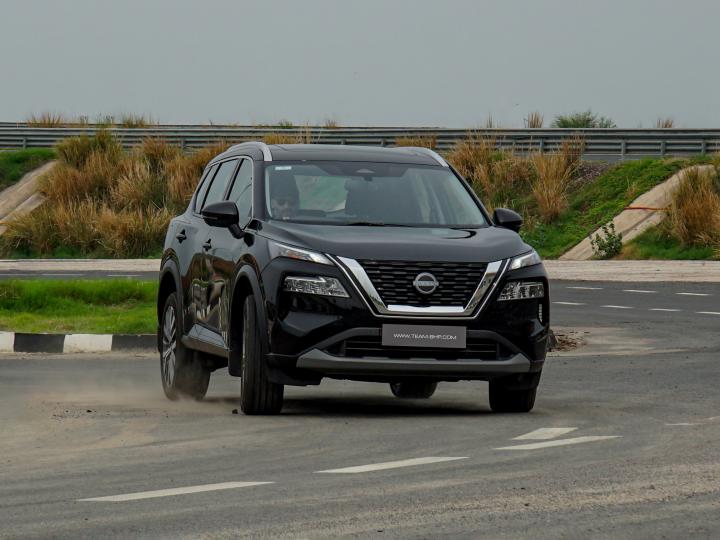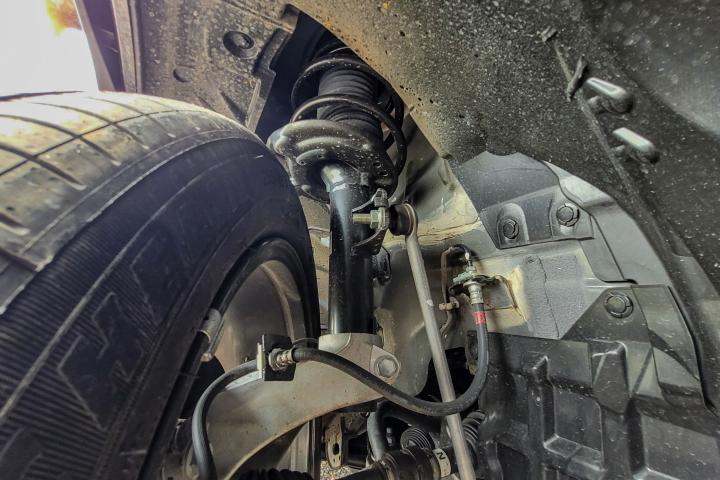News
2024 Nissan X-Trail : Observations after a day of driving
In Sport mode, the engine revs nicely till 6,000 rpm before the transmission shifts to the next step.
Driving the Nissan X-Trail 1.5L Turbo-Petrol CVT
1.5-litre, 3-cylinder turbo-petrol engine has Nissan’s patented variable compression technology and is mated to a CVT automatic. It produces 161 BHP @ 4,800 rpm and 300 Nm @ 2,800-3,600 rpm and powers the front wheels only:

Nissan is super hyped about this engine as it is the world’s first production variable compression ratio engine. It uses a multi-link system that varies the piston’s top dead centre (TDC) and bottom dead centre (BDC) positions which changes the compression ratio as per the requirement of power or efficiency. In simple words, a higher compression ratio helps in better combustion and greater fuel efficiency and a lower compression ratio helps in getting more power. In this Nissan engine, the compression ratio can be varied from 8:1 under full load to 14:1 under light load. For reference, the Hyundai 1.5-litre turbo-petrol engine has a compression ratio of 10.5:1.

Typically with turbocharged engines, manufacturers lower the compression ratio to reduce the chances of knocking or detonation due to high compression. However, when cruising, when the engine is off boost, the engine is still on a lower compression ratio. Theoretically, this cruising period can be used to gain more efficiency as the power demand is low. Thus a higher compression ratio would help in extracting more efficiency. That’s exactly what Nissan has done by modifying the conventional piston-connecting rod system. Instead of a single connecting rod, you have a multi-link system that is further connected to an actuator which decides the ideal compression ratio of the engine based on the throttle input. To make this happen, there are various other components as well that need to be specifically designed. There’s a wide-range turbocharger and electric wastegate. It allows for control of the boost pressure and reduces the turbo lag. The valves also are specifically designed for introducing the optimum air-fuel mixture.

With the technical bits out of the way, let’s get to the driving part. At idle, the engine is quite refined and you don’t hear it inside the cabin or even on the outside. You’ll probably forget that there’s a 3-cylinder engine purring under the bonnet. Shift into D and the car gets off the line smoothly. Being a CVT, it gets up to speed quite smoothly. The throttle response is good and you get a linear delivery of power. This is an 8-step gearbox. The upshifts are quite smooth and so are the downshifts. Even the response from the transmission to throttle inputs is quick and not like your typical CVTs. All the tech that sounds good in theory and works well in practical life as well. The engine, despite being turbocharged and mated to a CVT, isn’t dead at low revs. You can get up to speed without feeling that the unit is strained. You go up and down the steps of the CVT quite seamlessly and driving around in the city is pretty effortless. The car is also responsive enough for quick overtakes and you will enjoy driving it.
Get on the highway and flex your right foot to build up some revs. Knowing that this is a 3-cylinder engine, the expectations weren’t high, but the way it performed was surely surprising. Outright performance is good and the engine has a strong mid-range. Overtaking on the highway won’t be an issue. In Sport mode, the engine revs nicely till 6,000 rpm before the transmission shifts to the next step. You’ll also appreciate that the engine isn’t dead at the top end. While it does flatten a bit in the upper reaches of the power band, it isn’t dead like you see in the case of some of the turbo-petrol engines in the market. This is where the variable compression works brilliantly. Surprisingly, the exhaust also sounds nice when you rev the engine. It doesn’t sound strained or coarse. Cruising is also a comfortable affair in the X-Trail and you will see the engine revving at a comfortable 1,500 rpm at 100 km/h and 1,750 rpm at 120 km/h in the 8th step of the CVT.
The third generation XTRONIC CVT has 8 steps and is very nicely coupled to this engine. In terms of behaviour, it has some traits of a torque converter as well as a dual-clutch. It is quick to respond to throttle inputs like a dual-clutch and it is smooth at slow speeds like a torque converter. But being a CVT, it does have the rubber band effect when you floor the accelerator. It’s not as pronounced as some of the budget CVTs that you might have seen, but it’s still there. You also get paddle shifters to move in between the steps and they’re not gimmicky. You can use them for upshifts and downshifts, although they aren’t as intuitive as in dual-clutch gearboxes. There is also an S mode which is activated when you pull down the transmission selector once when in D. In this mode, the transmission holds on to the steps for a bit longer and only upshifts when the revs reach 6,000 rpm.
There are three drive modes available –
Eco Mode: This is where the engine and transmission are in the most economical mode. The throttle response is dull and the transmission upshifts early to reach the highest step for enhancing fuel economy. However, it’s not a complete dud and you can drive around in the city quite comfortably in Eco mode. There is enough power on tap for quick overtakes and keeping up with traffic. The A/C, however, keeps cutting off from time to time for efficiency.
Standard Mode: Not much of a difference from the Eco mode. The throttle response improves slightly and the engine feels like it has a bit more pep. The A/C doesn’t cut off randomly and you can drive around the city or on the highway in this mode.
Sport Mode: As expected, this is where all the parameters get amplified. The throttle response is sharper and the steering gets a bit more heft (it's still light though). The transmission holds on to the steps longer in this mode. You’ll want to use this mode when you are pushing the car hard on some empty twisty roads. Surprisingly, Sport mode isn’t too spiky and you can still drive around normally in it.
All in all, the performance of this powertrain is good. The technology does translate from theory to practicality quite nicely and delivers. However, in terms of outright performance, it is nowhere close to the Skoda Kodiaq 2.0L turbo-petrol DSG. It is not slow though and will do the 0-100 km/h sprint in 9.6 seconds, which is fast enough for most drivers. Where this powertrain excels is providing a smooth and linear power delivery that is very much usable in daily driving conditions as well as on the occasional highway trips.
Noise, Vibration & Harshness (NVH)
The refinement levels of the X-Trail are good and you barely hear the engine in the cabin at idle. Even on the outside, the engine is relatively silent. The engine has a nice exhaust note and doesn’t sound strained at high revs. Wind noise is well controlled when driving at 120 km/h. Our test car’s Michelin Primacy 4 tyres kept the road noise well in check.
Mileage & Fuel economy
The Nissan X-Trail is equipped with a mild hybrid system with a lithium-ion battery for better fuel economy and reduced emissions. There’s also an idling start-stop system for better fuel economy. The car has a 55-litre fuel tank and a claimed fuel efficiency is 13.7 km/l. We will have to wait for some ownership reviews to get the real-world fuel efficiency figures.
Recommended fuel for the X-Trail is 95 Octane and it is not E20 compatible:

Suspension

Ride Comfort
The X-Trail is equipped with an independent strut suspension at the front and you get a multi-link independent rear suspension. This is a good setup mechanically and you can feel it while driving as well. The suspension is quite absorbent and can take small to medium-sized potholes with ease. It works silently as well. The biggest concern, however, are the 20-inch wheels with 255/45 section tyres. While the suspension is absorbent, the big wheels and shorter tyre sidewalls make the ride feel stiff. Unfortunately, there is no variant with a smaller wheel size. Over bad roads, the suspension feels a bit busy as there is always some body movement. The ride feels better when on the highway as the expansion joints and road undulations are handled effortlessly.
Handling & Dynamics

The Nissan X-Trail is a predictable handler. Straight line stability is good and you don’t realize the speeds that you are doing. It feels very composed and not bouncy. The vertical movement at high speeds is well controlled. This is a good trait for long-distance cruising.
In terms of dynamics, the X-Trail is neutral and isn’t much of a corner carver. The multi-link rear suspension helps in keeping the car stable in the corners, but it’s not a vehicle that you would enjoy pushing hard in the curves. There is body roll and if pushed hard, it feels a bit top heavy. This is when you would back off the throttle. Our test car was equipped with Michelin Primacy 4 tyres which provided excellent grip.
Steering
The steering is light at city speeds which makes driving and parking this SUV pretty easy. It weighs up on the highways, but not as much as we’d have liked. Some more heft at high speeds would have been appreciated. There is an option to increase the steering weight through the MID, but even in the Sport setting, it is still light. The lightness of the steering is one of the reasons why you will be backing off the throttle in a corner. While the steering feels direct, its lightness doesn’t inspire confidence while pushing hard. The X-Trail has a turning radius of 5.5 meters.
Braking
The X-Trail comes with an all-wheel disc brake setup. The brakes do a good job of bringing the car to a halt without any drama. The pedal feel is consistent and the brakes are easy to modulate.
Â
Continue reading the discussion on the Nissan X-Trail on our forum.













.jpg)










